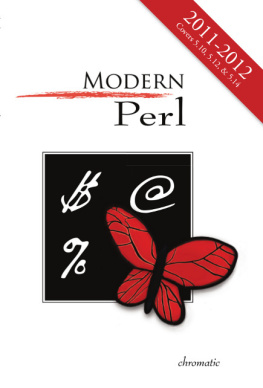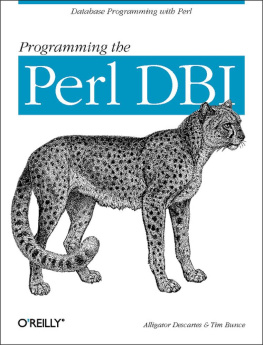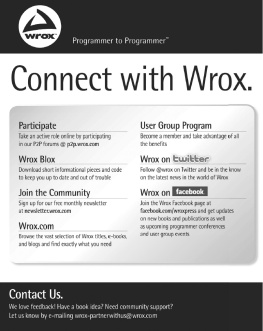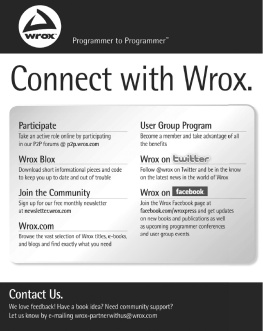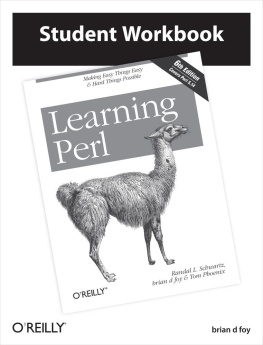chromatic - Modern Perl: 2011-2012
Here you can read online chromatic - Modern Perl: 2011-2012 full text of the book (entire story) in english for free. Download pdf and epub, get meaning, cover and reviews about this ebook. City: Hillsboro, Or, year: 2012, publisher: Onyx Neon Press, genre: Computer. Description of the work, (preface) as well as reviews are available. Best literature library LitArk.com created for fans of good reading and offers a wide selection of genres:
Romance novel
Science fiction
Adventure
Detective
Science
History
Home and family
Prose
Art
Politics
Computer
Non-fiction
Religion
Business
Children
Humor
Choose a favorite category and find really read worthwhile books. Enjoy immersion in the world of imagination, feel the emotions of the characters or learn something new for yourself, make an fascinating discovery.
Modern Perl: 2011-2012: summary, description and annotation
We offer to read an annotation, description, summary or preface (depends on what the author of the book "Modern Perl: 2011-2012" wrote himself). If you haven't found the necessary information about the book — write in the comments, we will try to find it.
Modern Perl: 2011-2012 — read online for free the complete book (whole text) full work
Below is the text of the book, divided by pages. System saving the place of the last page read, allows you to conveniently read the book "Modern Perl: 2011-2012" online for free, without having to search again every time where you left off. Put a bookmark, and you can go to the page where you finished reading at any time.
Font size:
Interval:
Bookmark:

Modern Perl is one way to describe the way the world's most effective Perl 5 programmers work. They use language idioms. They take advantage of the CPAN. They show good taste and craft to write powerful, maintainable, scalable, concise, and effective code. You can learn these skills too!
Perl first appeared in 1987 as a simple tool for system administration. Though it began by declaring and occupying a comfortable niche between shell scripting and C programming, it has become a powerful, general-purpose language family. Perl 5 has a solid history of pragmatism and a bright future of polish and enhancement Perl 6 is a reinvention of programming based on the solid principles of Perl, but it's a subject of another book..
Over Perl's long historyespecially the 17 years of Perl 5our understanding of what makes great Perl programs has changed. While you can write productive programs which never take advantage of all the language has to offer, the global Perl community has invented, borrowed, enhanced, and polished ideas and made them available to anyone willing to learn them.
The Modern::Perl module from the CPAN () asks Perl to warn of dubious constructs and typos and will enable new features introduced in modern releases of Perl 5. Unless otherwise mentioned, code snippets always assume the basic skeleton of a program:
#!/usr/bin/env perl use Modern::Perl 2011; use autodie;... which is equivalent to:
#!/usr/bin/env perl use 5.012; # implies "use strict;" use warnings; use autodie;Some examples use testing functions such as ok(), like(), and is() (). These programs follow the pattern:
#!/usr/bin/env perl use Modern::Perl; use Test::More; # example code here done_testing();At the time of writing, the current stable Perl 5 release family is Perl 5.14. The examples in this book work best with Perl 5.12.0 or newer. Many examples will work on older versions of Perl 5 with modest changes, but you will have more difficulty with anything older than 5.10.0.
If you have no Perl 5 installed (or if you have an old version installed), you can install a newer release yourself. Windows users, download Strawberry Perl from http://www.strawberryperl.com/ or ActivePerl from http://www.activestate.com/activeperl. Users of other operating systems with Perl 5 already installed (and a C compiler and the other development tools), start by installing the CPAN module App::perlbrew See http://search.cpan.org/perldoc?App::perlbrew for installation instructions..
perlbrew allows you to install and manage multiple versions of Perl 5. This allows you to switch between versions of Perl 5 as well as to install Perl 5 and CPAN modules in your home directory without affecting the system's version. If you've ever had to beg your system administrator for permission to install software, you know how much easier your life can be now.
This book would not have been possible without questions, comments, suggestions, advice, wisdom, and encouragement from many, many people. In particular, the author and editor thank:
John SJ Anderson, Peter Aronoff, Lee Aylward, Alex Balhatchet, var Arnfjr Bjarmason, Matthias Bloch, John Bokma, Vasily Chekalkin, Dmitry Chestnykh, E. Choroba, Tom Christiansen, Anneli Cuss, Paulo Custodio, Steve Dickinson, Kurt Edmiston, Felipe, Shlomi Fish, Jeremiah Foster, Mark Fowler, John Gabriele, Andrew Grangaard, Bruce Gray, Ask Bjrn Hansen, Tim Heaney, Graeme Hewson, Robert Hicks, Michael Hind, Mark Hindess, Yary Hluchan, Daniel Holz, Mike Huffman, Gary H. Jones II, Curtis Jewell, Mohammed Arafat Kamaal, James E Keenan, Kirk Kimmel, Yuval Kogman, Jan Krynicky, Michael Lang, Jeff Lavallee, Moritz Lenz, Andy Lester, Jean-Baptiste Mazon, Josh McAdams, Gareth McCaughan, John McNamara, Shawn M Moore, Alex Muntada, Carl Msak, Chris Niswander, Nelo Onyiah, Chas. Owens, ww from PerlMonks, Jess Robinson, Dave Rolsky, Gabrielle Roth, Jean-Pierre Rupp, Eduardo Santiago, Andrew Savige, Lorne Schachter, Steve Schulze, Dan Scott, Alexander Scott-Johns, Phillip Smith, Christopher E. Stith, Mark A. Stratman, Bryan Summersett, Audrey Tang, Scott Thomson, Ben Tilly, Ruud H. G. van Tol, Sam Vilain, Larry Wall, Lewis Wall, Colin Wetherbee, Frank Wiegand, Doug Wilson, Sawyer X, David Yingling, Marko Zagozen, harleypig, hbm, and sunnavy.
Any remaining errors are the fault of the stubborn author.
Perl gets things doneit's flexible, forgiving, and malleable. Capable programmers use it every day for everything from one-liners and one-off automations to multi-year, multi-programmer projects.
Perl is pragmatic. You're in charge. You decide how to solve your problems and Perl will mold itself to do what you mean, with little frustration and no ceremony.
Perl will grow with you. In the next hour, you'll learn enough to write real, useful programsand you'll understand how the language works and why it works as it does. Modern Perl takes advantage of this knowledge and the combined experience of the global Perl community to help you write working, maintainable code.
First, you need to know how to learn more.
Perl has a culture of useful documentation. The perldoc utility is part of every complete Perl 5 installation However your Unix-like system may require you to install an additional package such as perl-doc on Debian or Ubuntu GNU/Linux.. perldoc displays the documentation of every Perl module installed on the systemwhether a core module or one installed from the Comprehensive Perl Archive Network (CPAN)as well as thousands of pages of Perl's copious core documentation.
http://perldoc.perl.org/ hosts recent versions of the Perl documentation. CPAN indexes at http://search.cpan.org/ and http://metacpan.org/ provide documentation for all CPAN modules. Other Perl 5 distributions such as ActivePerl and Strawberry Perl provide local documentation in HTML formats.
Use perldoc to read the documentation for a module or part of the core documentation:
$ perldoc List::Util $ perldoc perltoc $ perldoc Moose::ManualThe first example displays the documentation embedded within the List::Util module. The second example displays a pure documentation file, in this case the table of contents of the core documentation. The third example displays a pure documentation file included as part of a CPAN distribution (). perldoc hides these details; there's no distinction between reading the documentation for a core library such as Data::Dumper or one installed from the CPAN.
The standard documentation template includes a description of the module, demonstrates sample uses, and then contains a detailed explanation of the module and its interface. While the amount of documentation varies by author, the form of the documentation is remarkably consistent.
How to Read the Documentation
perldoc perltoc displays the table of contents of the core documentation, and perldoc perlfaq displays the table of contents for Frequently Asked Questions about Perl 5. perldoc perlop and perldoc perlsyn document Perl's symbolic operators and syntactic constructs. perldoc perldiag explains the meanings of Perl's warning messages. perldoc perlvar
Font size:
Interval:
Bookmark:
Similar books «Modern Perl: 2011-2012»
Look at similar books to Modern Perl: 2011-2012. We have selected literature similar in name and meaning in the hope of providing readers with more options to find new, interesting, not yet read works.
Discussion, reviews of the book Modern Perl: 2011-2012 and just readers' own opinions. Leave your comments, write what you think about the work, its meaning or the main characters. Specify what exactly you liked and what you didn't like, and why you think so.

